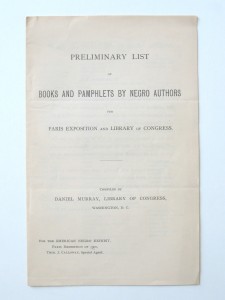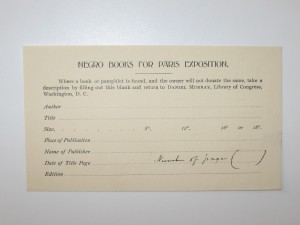Toward the end of his now-famous 1897 Atlantic Monthly essay, “Strivings of the Negro People,” W.E.B. DuBois states that the post-Civil War years brought for African Americans “the ideal of book-learning, the curiosity, born of compulsory ignorance.” Historians may note DuBois’ ultimate discontent with this ideal — the longing to achieve freedom through ‘book-learning” — but they also note the real attainments of individuals like Daniel Alexander Payne Murray, first black Assistant Librarian of Congress.
AAS has an interesting connection to Daniel Murray. We hold a copy of his Preliminary List of Books and Pamphlets by Negro Authors for Paris Exposition and Library of Congress.  The list is accompanied by a January 22, 1900 call for all men of “the co-operation of men of literary knowledge” to “get a copy of every book or pamphlet written by a colored man” for the 1900 Paris Exposition and Library of Congress.
The list is accompanied by a January 22, 1900 call for all men of “the co-operation of men of literary knowledge” to “get a copy of every book or pamphlet written by a colored man” for the 1900 Paris Exposition and Library of Congress.
Wishing to find more information on Murray’s connection to AAS, I went to the American Antiquarian Society’s Proceedings and discovered that Murray had specifically requested the aid of Edmund M. Barton, AAS’s head librarian from 1881-1908, in preparing the list. “No doubt many rare pamphlets are now in the collection of your Society and it is to have a list of them for bibliographical purposes that I will address you,” Murray wrote. “Mr. Edward C. Goodwin [U. S. Senate Librarian] gave me your name and urged me to write… I enclose penalty envelope for your reply, and labeled for any package you could collect from your duplicates or from some colored people in your vicinity” (AAS Proceedings, XIII).
We have no idea which works, if any, Barton contributed to the exposition. He must have contributed at least a few of the famed pamphlets, as Murray later gifted the society with a diary of Paul Jennings. The Jennings work is part of Murray’s bibliography, and the AAS valued Murray’s donation as exceedingly valuable. (For curious readers, the AAS copy is cataloged as part of the Bladensburg series. If any reader of this blog has further information on why the Jennings work is part of the Bladensburg series, or any further information on the nature of the Bladensburg series, please let us know! Here is the AAS catalog link to Jennings diary.)
It was during those key years after the Civil War that Daniel Murray established his role with the Library of Congress, rose to the rank of assistant librarian, and created a bibliography of “Negro” authors for the Paris Exposition. Murray’s exhibit, a success for bibliographers and African-Americans at home and abroad, was nothing less than a display of the achievements of black authorship in America, put on display for the world to see.
Want to Learn More?
Libraries & Culture vol. 40.1 (2005): 25-37, recently published a fascinating treatment of Murray. For those interested in further reading on the Paris Exposition and race, see Smith, Shawn Michelle Smith’s American Archives: Gender, Race, and Class in Visual Culture (Princeton, 1999).

Please add Shawn Michelle Smith’s wonderful book, Photography on the Color Line: W. E. B. Du Bois, Race, and Visual Culture (Duke, 2004) to your “Want to Learn More?” list. It’s a continuation and expansion on the themes Smith explored in American Archives.